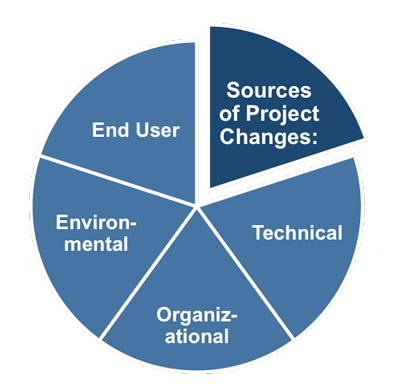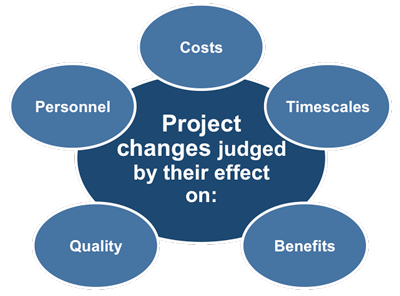Project Change Control Processes
This is the process of reviewing all change requests, approving changes and managing changes to the deliverables, project documents and the project plan. It is conducted from project initiation through completion because no matter how carefully planned a project has been, changes will need to be made throughout its life cycle. This is one of the most important areas of the project because the cost of implementing changes goes up as the project progresses. Therefore, it is best to make essential changes as soon as possible in the project.
Any stakeholder involved with the project may request changes. For example, end-users may realize that their requirements have changed or testing of a product may show that it is inappropriate in some unforeseen way. The business may be affected by changes in legislation, changes in government policy or changes in business strategy. It is also possible that project team members may believe that an emerging technology may offer a better solution to that originally planned or that a product just might not work the way that it was supposed to.
All of these potential changes need a process to control them and their effect on the project. This process, called change control, should ensure that proposed changes are interpreted in terms of their potential effect on project timescales, costs, benefits, quality and personnel.
This means that although they may be initiated verbally, they should always be recorded in written form and entered into a change management system as a formal change request. As such, they will be subject to the process specified in the change control system and must be either approved or rejected.
If a change request or document update request is raised, then an impact analysis should be performed. This process looks at the knock-on effects of the change on other products, and also the effect if the changes are not implemented. This decision is usually taken by the project manager or a change control board (CCB) responsible for approving or rejecting change requests. The purpose of the impact analysis is to arrive at a balanced view of the effect of the proposed change on the projects ability to satisfy its mandate. This will enable project management to decide whether to proceed with the change or not.
Approved change requests can require new or revised cost estimates, activity sequences, schedule dates, resource requirements, and analysis of risk response alternatives. The applied level of change control is dependent upon the application area, complexity of the specific project, contract requirements, and the context and environment in which the project is performed.
 |
These changes will result from both external influences as well as problems that arise within the project environment. The four main sources of change are:
1) Environmental: resulting from changes in legislation, government policy, or business strategy.
2) Organizational: High-level business decisions may change the basic terms of reference of the project - for example, there may be a change to the overall scope of the project.
3) End-User: resulting from changes in customer requirements. It is also possible that feedback gained during the review or testing of a product may show that it is unsuitable in some unexpected way.
4) Technical: New technology may offer a better solution to that originally planned. Alternatively, technical problems may prevent a product from working in the way that it was supposed to.
All of these potential changes need a process to control them and their effect on the project. This process, called change control, should ensure that proposed changes are interpreted in terms of their potential effect on project timescales, costs, benefits, quality, and personnel.
 |
Where there is a proposed alteration to the project's products, change control should analyze the change and assess its impact, prioritize and plan the necessary work, and finally control its implementation.
Any person associated with a project should be able to raise any concern they have at any time. The concern may involve a perceived problem or a suggestion for an improvement to some area of the work, documentation, or project organization. These issues should be reviewed at regular meetings.
 |
There are three possible outcomes when an issue is considered:
1. A change to the design or features of a product may be agreed. This will mean changing the way the product is specified in the plans and updating any costs and timescales accordingly. An impact analysis should also be performed.
This process looks at the knock-on effects of the change on other deliverables, and also the effect if the changes are not implemented. The purpose of the impact analysis is to arrive at a balanced view of the effect of the proposed change on the project's ability to satisfy its mandate. This will enable the project manager to decide whether to proceed with the change or not.
2. The proposed change is rejected because it is not felt to represent a significant concern.
3. The third option is unusual but it does occasionally happen that a deliverable does not agree with its specification and changing the specification is a better solution than changing the deliverable.
Where changing the deliverable is thought to be the best option, the project manager should use the impact analysis to assess the change in terms of its effect on timescales, cost, benefit, quality, personnel, and risk and to decide at what level the decision to proceed should be taken. He or she should then determine whether or not the proposed change is significant enough to be referred back to the sponsor.
Change control meetings involve the CCB described previously. The roles and responsibilities of these boards are clearly defined and agreed upon by appropriate stakeholders and documented in the change management plan. CCB decisions are documented and communicated to the stakeholders for information and follow-up actions.
These involve people who are responsible for managing the project work including the project manager, the project sponsor, selected project team members, selected stakeholders, anyone with responsibility for any of the project management processes, and others as needed.
Collective decision-making is very important area of project management that can make or break this part of the project. It will involve meetings between the project manager, the team and other stakeholders in order to make decisions about the activity definitions and associated estimates. How well these meetings are conducted will have a major impact on how smoothly the project runs.
If you feel as though your project meetings could be improved then you can download the 'Meeting Skills' eBooks from this website. These free eBooks cover all aspects of meetings including how to set an agenda that will ensure that the meeting achieves it's aims and how to chair a meeting so that it is as productive as possible.
You may also be interested in:
Project Management Processes | Project Initiation Processes | Project Planning Processes | Project Executing Processes | Project Monitoring and Controlling Processes | Project Change Control Processes | Project Closure Processes.
|
|


